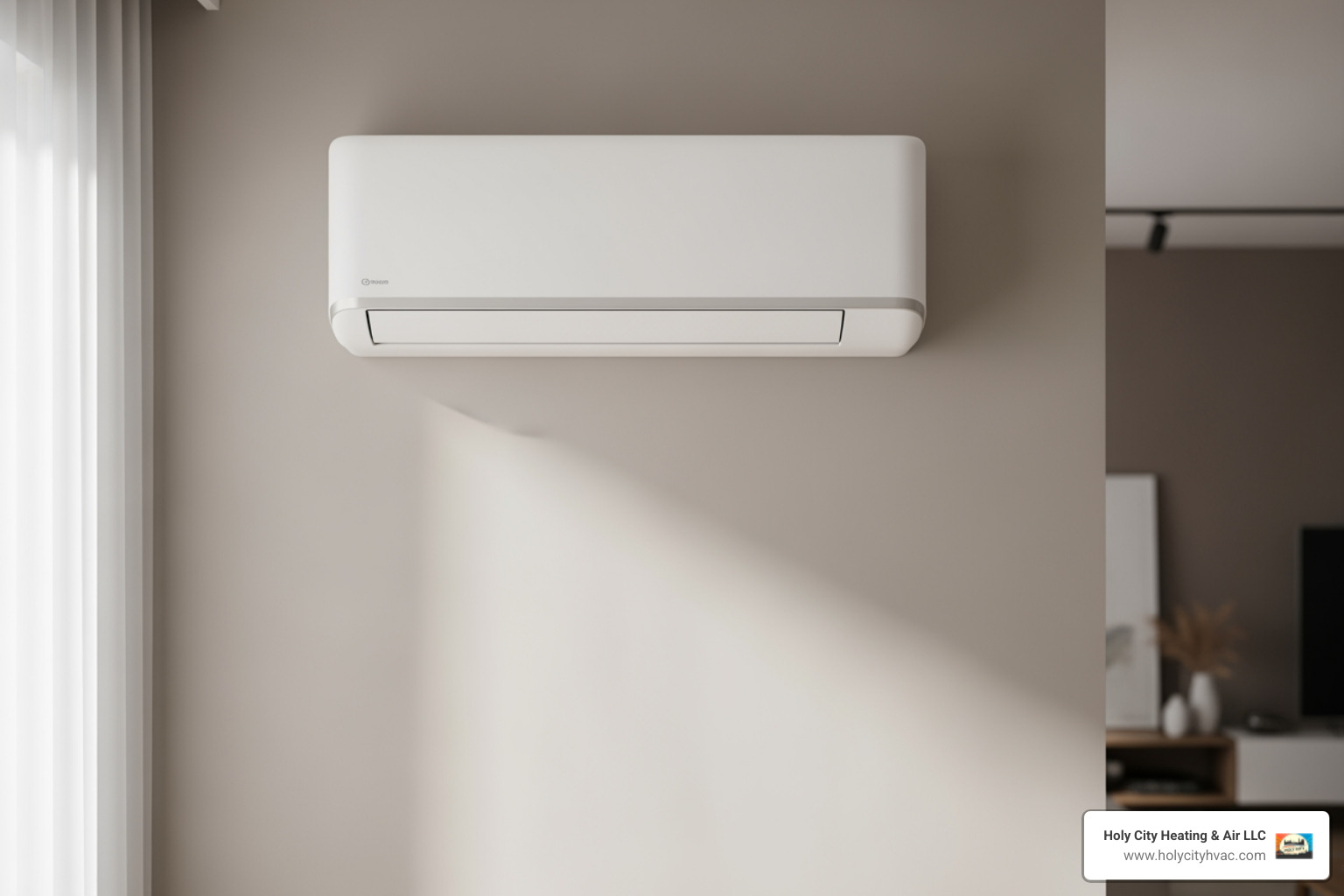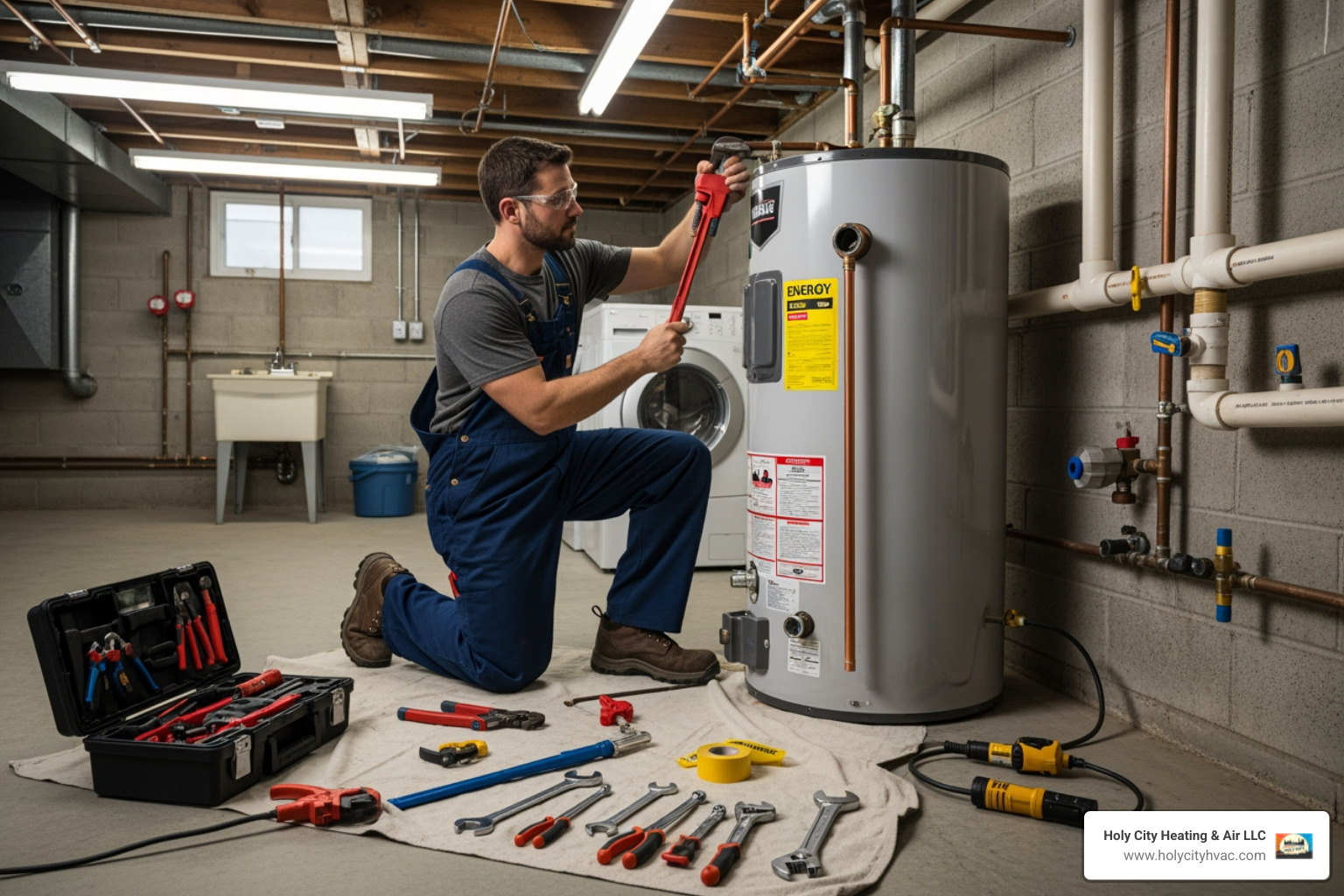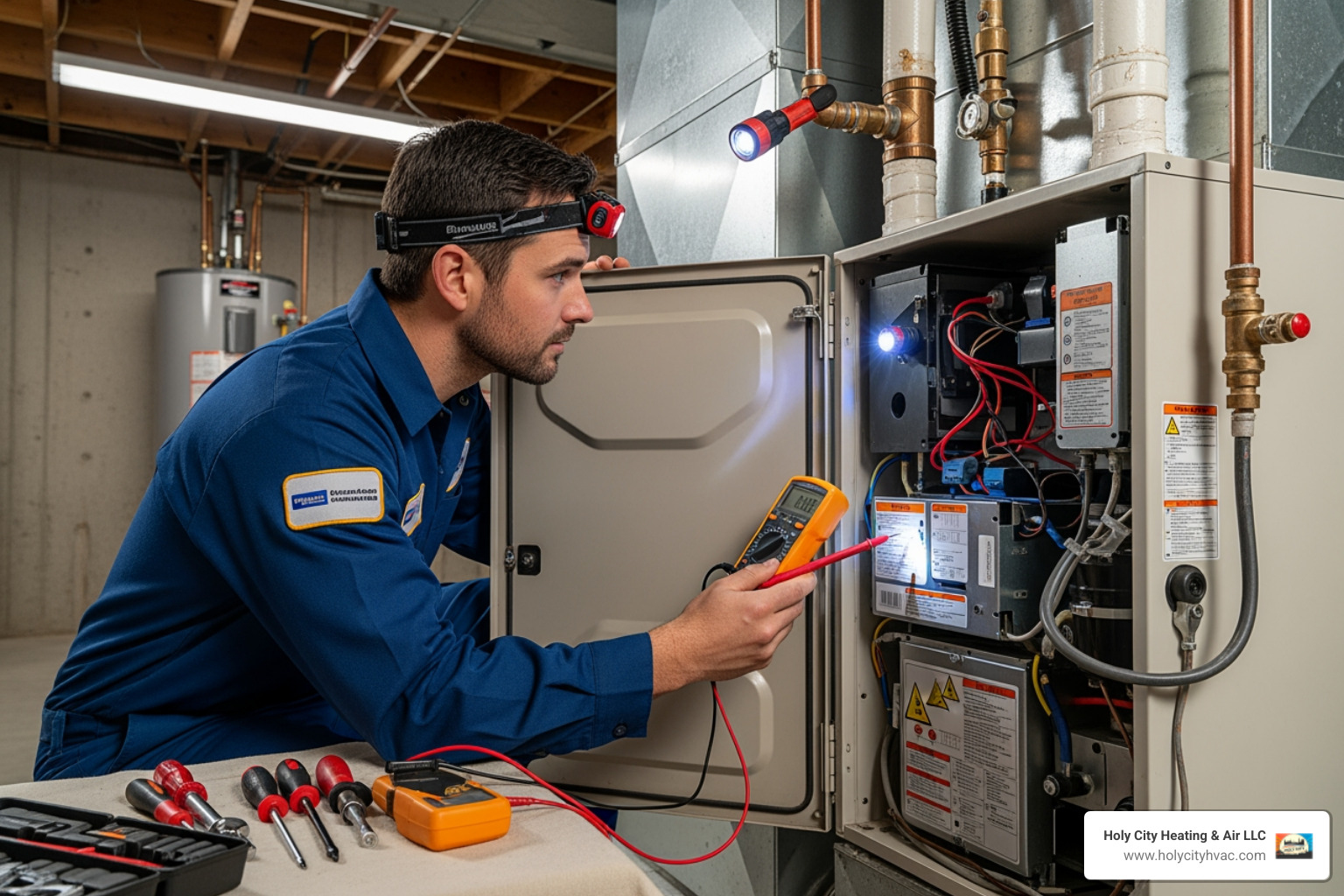
Why Furnace Blower Motor Replacement is Critical for Your Home's Comfort
Furnace blower motor replacement becomes necessary when your heating system's most important component - the motor that circulates warm air throughout your home - starts to fail. This vital part moves air over the heat exchanger and pushes it through your ductwork to keep every room comfortable.
Quick Answer for Furnace Blower Motor Replacement:
- Signs you need replacement: No airflow, unusual noises (grinding, squealing), or intermittent operation
- Professional replacement cost: Typically ranges from $300-$700 including parts and labor
- Motor lifespan: Usually lasts 10-20 years with proper maintenance
- DIY vs Professional: Professional installation recommended due to electrical safety and proper wiring requirements
When your furnace blower motor fails, you'll notice it immediately. Your home stops getting warm air from the vents, or you might hear strange grinding and squealing sounds coming from your furnace. These motors work hard - they're responsible for moving all the air that heats your Charleston area home.
The good news? Replacing a blower motor is much more affordable than replacing your entire furnace. A new motor can restore your system's efficiency and get your home comfortable again quickly.
Understanding when to repair versus replace is key. Sometimes the issue might be as simple as a bad capacitor or dirty blower wheel. Other times, especially with motors over 15 years old, full replacement makes the most sense.
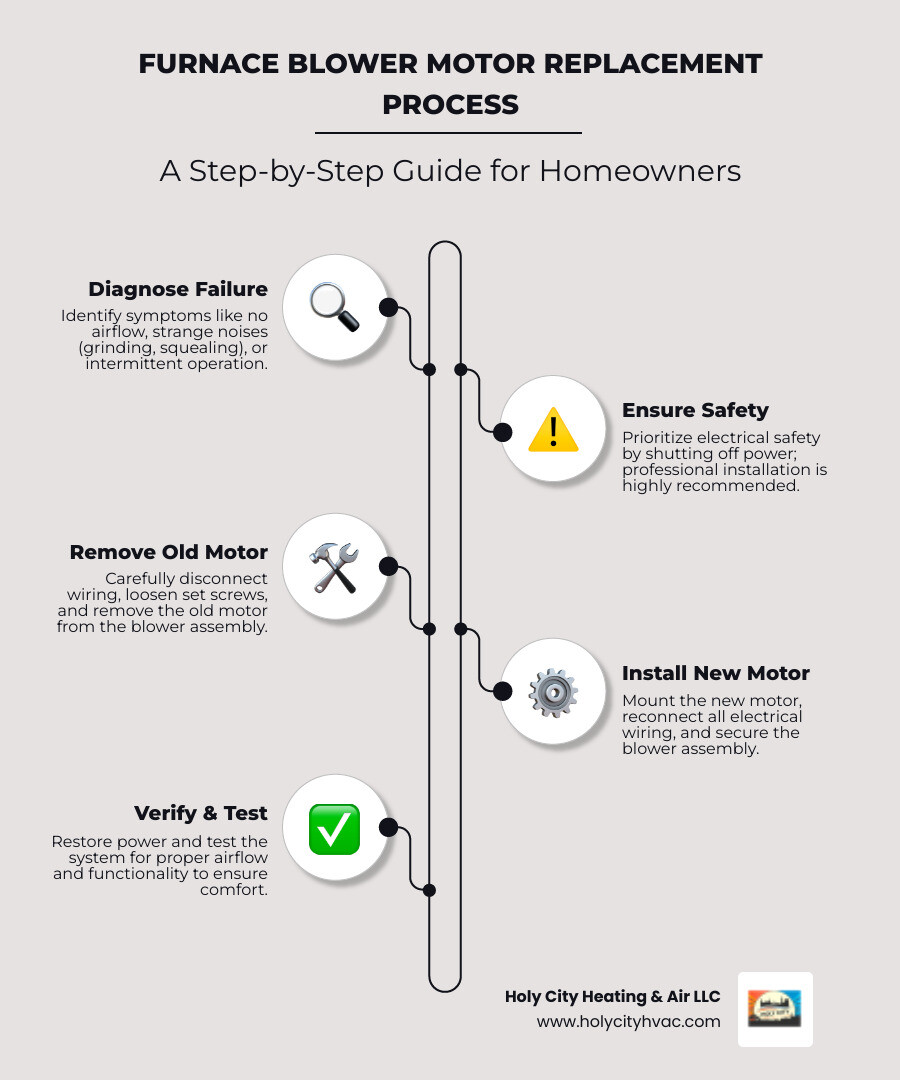
What is a Furnace Blower Motor and What Are the Signs of Failure?
The furnace blower motor is the heart of your home's heating system. When your thermostat calls for heat, this motor powers a fan (the blower wheel) that pulls in cool air, pushes it across the heat exchanger to warm it up, and then circulates the heated air through your ducts to every room. Without a working blower motor, your furnace can generate heat, but it can't deliver it where it's needed. A furnace is a key part of your HVAC system, and the blower motor is essential for your comfort.
Common Signs of a Failing Blower Motor
A failing blower motor usually gives warning signs. Here’s what to watch and listen for:
- Weak or no airflow from vents: This is the most obvious red flag. Some rooms may feel cold while others heat up.
- Strange noises: Grinding or squealing sounds often mean the motor's bearings are worn. A humming or buzzing noise can indicate the motor is trying to start but can't, possibly due to a bad capacitor. Rattling or banging sounds are serious and could mean loose parts or a damaged blower wheel.
- Higher energy bills: A failing motor works harder and uses more electricity to move the same amount of air.
- Intermittent operation or overheating: If the furnace cycles on and off unexpectedly or the blower stops mid-cycle, the motor may be overheating.
Types of Furnace Blower Motors
Understanding the two main types of motors helps with furnace blower motor replacement decisions.
- Single-Speed PSC Motors: Permanent Split Capacitor (PSC) motors are the traditional option. They operate at one speed—full blast or off. They are less expensive upfront but also less energy-efficient.
- Variable-Speed ECM Motors: Electronically Commutated Motors (ECM) are the modern, efficient choice. They adjust their speed based on your home's heating needs, providing consistent comfort, quieter operation, and significant energy savings. While they cost more upfront, their long-term savings and superior performance make them a worthwhile investment. As of July 2019, new furnaces are required to use these more efficient motors.
Whether you have a PSC motor or are considering an ECM upgrade, the goal is to restore proper and safe airflow to your home.
The Complete Guide to Furnace Blower Motor Replacement
Safety is paramount with furnace blower motor replacement. This job involves high-voltage electrical components and, for gas furnaces, a gas line. Power must be shut off at the breaker and the gas valve closed before any work begins. While some DIYers may feel confident, the risk of electrical shock, incorrect wiring, and potential damage to the new motor makes professional service the smart choice. A single mistake can create a serious safety hazard. Our EPA-certified professionals have the expertise to perform the replacement safely and correctly.
Tools and Materials Used by Professionals
A professional furnace blower motor replacement requires specific tools and materials to ensure the job is done right.
- The New Blower Motor: Must be an exact match for the furnace's horsepower, RPM, voltage, and frame size to prevent poor performance or failure.
- Replacement Capacitor: For PSC motors, a new capacitor is essential. An old capacitor can damage the new motor, so we always replace them together.
- Essential Tools: Our toolkit includes screwdriver and socket sets, pliers, wire nuts, and electrical tape for secure connections.
- Safety Gear: We use cut-resistant work gloves to protect against sharp sheet metal edges inside the furnace.
- Specialized Equipment: A camera is used to document wiring before disconnection, and a hub puller may be needed to safely remove a stubborn blower wheel from the old motor shaft.
How Professionals Replace a Furnace Blower Motor
Our professional furnace blower motor replacement process is meticulous to ensure safety and long-term performance.
- Safety First: We shut off power at the circuit breaker and close the gas supply valve.
- Access and Document: We remove the furnace panels to access the blower compartment and photograph all wire connections to ensure correct reassembly.
- Disconnect and Remove: We disconnect the wiring, safely discharge and remove the old capacitor (for PSC motors), and slide out the entire blower assembly.
- Separate Old Motor: The old motor is unbolted from its mounting bracket, and the blower wheel is carefully removed from the motor shaft, using a hub puller if necessary.
- Clean and Inspect: We thoroughly clean and inspect the blower wheel. A clean wheel is crucial for the new motor's efficiency and lifespan.
- Install New Motor: The mounting bracket is transferred to the new motor, which is then carefully installed into the blower housing and aligned with the wheel.
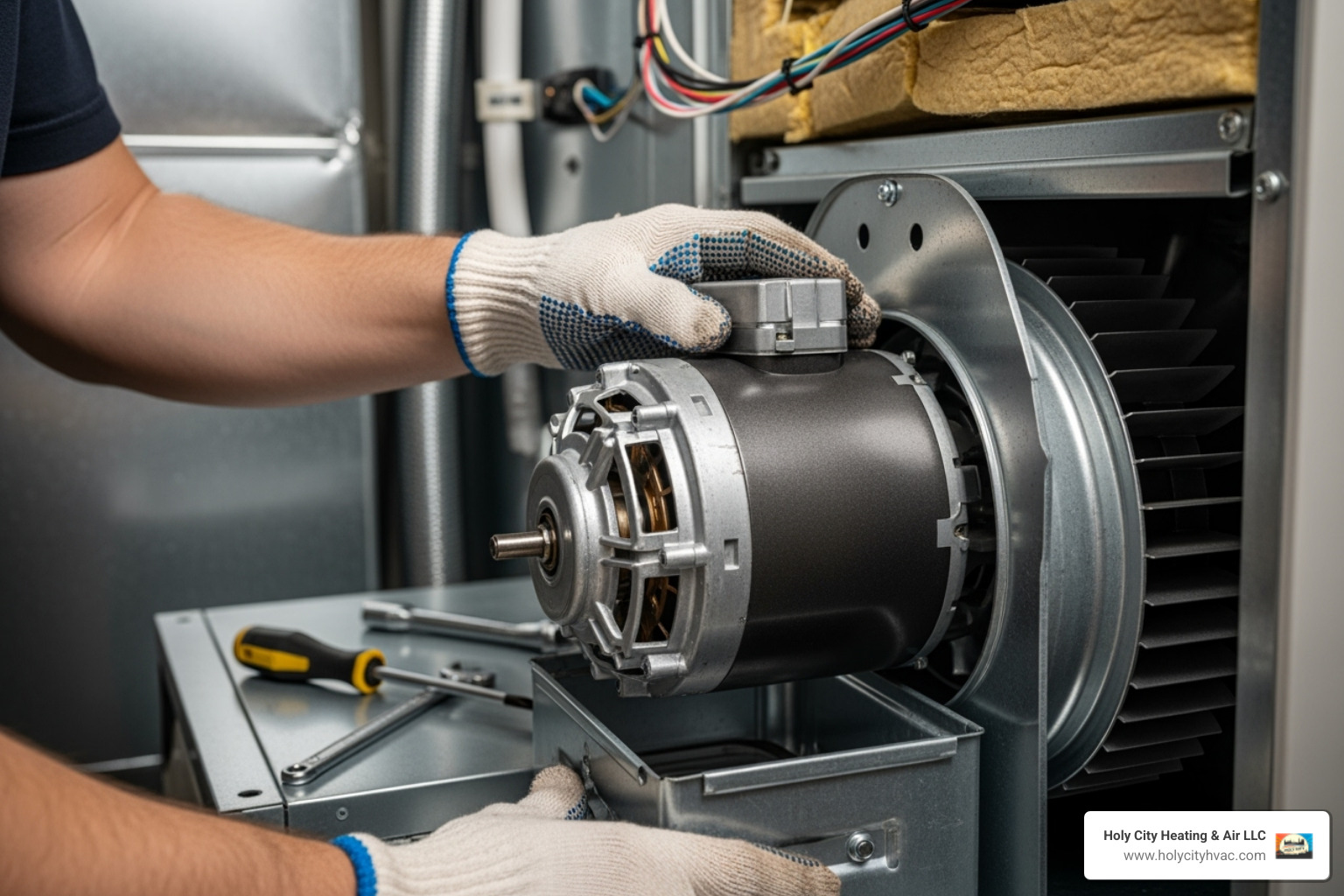
- Reconnect and Reassemble: We install the new capacitor (if applicable) and reconnect all wires using our photos as a guide. The assembly is then reinstalled in the furnace.
- Test: After replacing the panels, we restore power and test the furnace to confirm strong airflow and proper, quiet operation.
Learn more from the Practical Mechanic about the technical details of this process.
Why Choose Professional Furnace Blower Motor Replacement?
While the DIY approach is tempting, furnace blower motor replacement is a job best left to professionals for several key reasons:
- Electrical Safety: Furnaces contain high-voltage components and capacitors that can hold a dangerous electrical charge even when the power is off. Our licensed technicians are trained to handle these hazards safely.
- Proper Installation: A replacement motor must be correctly sized, balanced, and wired for your specific furnace. Mistakes can lead to poor efficiency, noise, or damage to the new motor and other components.
- Time Savings: A professional can complete the job in a few hours, whereas a DIY project can easily become a frustrating, time-consuming ordeal.
- Warranty Protection: Professional installation ensures your new motor's warranty remains valid, and our work is backed by a labor warranty for your peace of mind.
Can a Blower Motor Be Repaired?
In some cases, a blower motor can be repaired instead of replaced.
- Capacitor Replacement: For a PSC motor that hums but won't spin, a failed capacitor is a likely culprit. This is an inexpensive and common repair.
- Cleaning Components: A thorough cleaning of a dirty blower wheel can restore airflow and reduce strain on the motor, sometimes resolving performance issues.
- Oiling Bearings: On older motors, oiling the bearings can temporarily quiet squealing, but most modern motors are sealed and cannot be lubricated.
However, if the motor's internal windings are burned out or the bearings are shot, replacement is the most cost-effective solution. Our technicians can diagnose the true cause of the problem, which might even be a loose wire or faulty control board, and recommend the best course of action.
Understanding the Cost of a Furnace Blower Motor Replacement
The cost of a furnace blower motor replacement depends on several factors:
- Motor Type: Variable-speed ECM motors have a higher upfront cost than single-speed PSC motors but provide long-term energy savings and improved comfort.
- Labor Costs: This reflects the technician's expertise and time to ensure a safe and correct installation.
- Additional Parts: The cost may include a new capacitor (for PSC motors) or a replacement blower wheel if the original is damaged.
- System Complexity: The layout of your furnace can affect the time required for the replacement.
We provide transparent, upfront pricing so you understand the full cost before we begin any work.
Extending Your Motor's Life and When to Replace the Entire Furnace
Think of your furnace blower motor like the engine in your car - with proper care, it can serve you faithfully for years. But just like that car engine, there comes a time when you need to decide whether to keep fixing it or invest in something newer and more reliable.
The good news is that taking care of your blower motor isn't complicated, and the steps you take today can save you from an unexpected furnace blower motor replacement down the road.
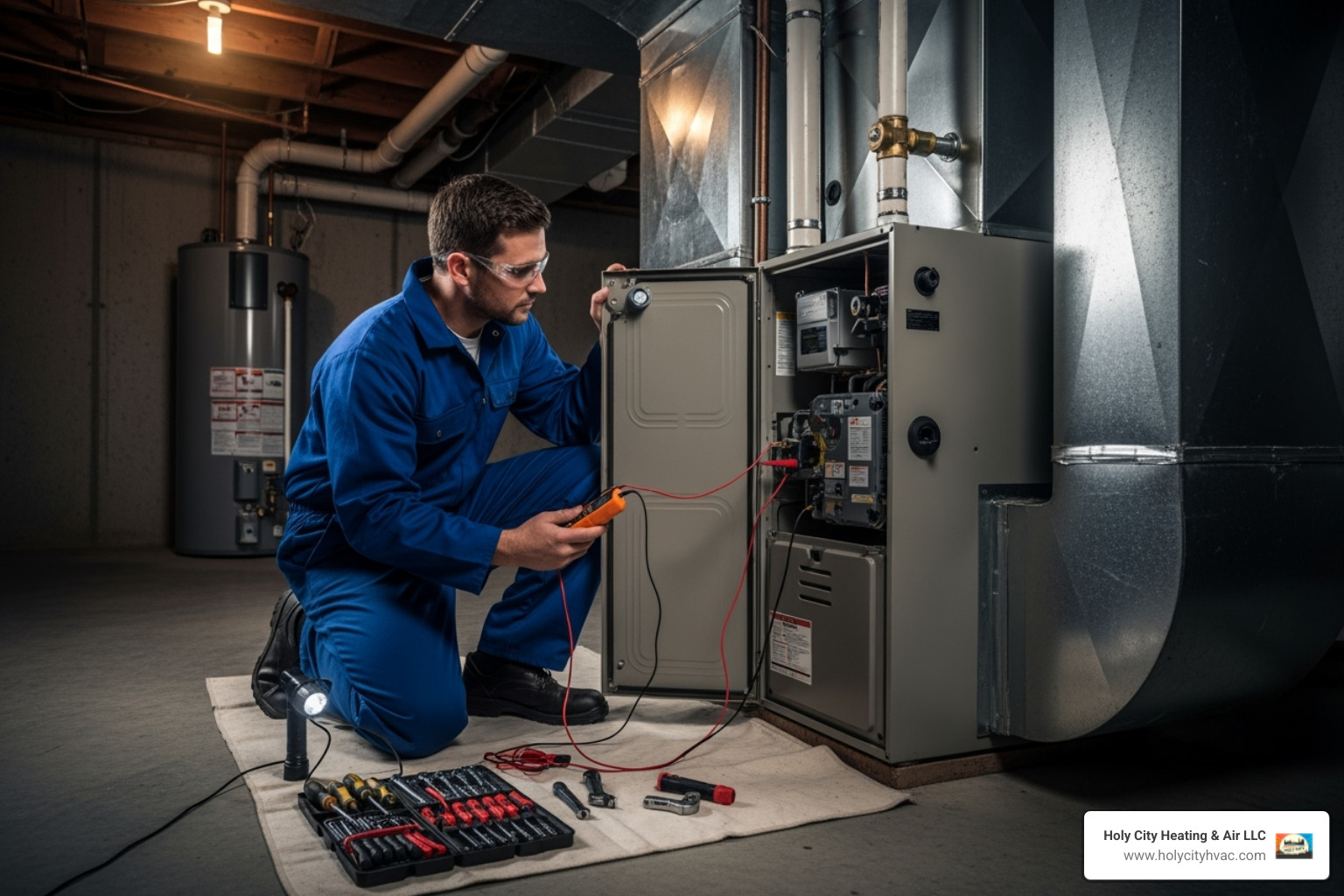
Maintenance Tips to Maximize Lifespan
Your furnace blower motor works hard, so a little care goes a long way. Here’s how to keep it running well:
- Change air filters regularly: This is the single most important thing you can do. A dirty filter restricts airflow, forcing your motor to work harder and wear out faster. Check filters monthly during peak seasons.
- Keep the furnace area clean: Dust can accumulate on the blower wheel, reducing efficiency and straining the motor.
- Listen for new noises: Squealing or grinding sounds are early warnings. Don't ignore them.
- Schedule annual professional maintenance: An annual inspection allows a technician to clean components, check electrical connections, and spot potential issues before they become major, expensive problems.
Blower Motor Replacement vs. Full Furnace Replacement
Sometimes a furnace blower motor replacement is the right call. Other times, it's better to replace the entire system. Here’s how to decide:
- Age: Most furnaces last 15-20 years. If your furnace is approaching this age and the motor fails, replacing the whole unit is often the wiser long-term investment. Investing in a major repair for an old system may not be cost-effective if other parts are likely to fail soon.
- Frequent Repairs: If you've had multiple service calls in the last few years, your furnace may be nearing the end of its life. Continual repair costs can add up, making a new system a more economical choice.
- Energy Efficiency: Modern furnaces with variable-speed ECM motors are significantly more efficient than older models. A new furnace can lead to substantial savings on your utility bills over time.
Our job is to provide the facts so you can make the best decision for your home and budget. We'll help you determine whether a motor replacement or a new system is the right choice for long-term comfort and savings.
Frequently Asked Questions about Furnace Blower Motors
We've heard just about every question you can imagine about furnace blower motors. Here are the answers to the most common ones.
What is the life expectancy of a furnace blower motor?
A furnace blower motor typically lasts 10 to 20 years. Its lifespan depends on factors like usage, motor quality (ECM vs. PSC), and, most importantly, regular maintenance. Consistent air filter changes and annual professional tune-ups are the best ways to maximize the life of your motor.
Is it worth replacing a furnace blower motor?
Yes, it is almost always worth replacing a blower motor, especially if your furnace is less than 15 years old. Furnace blower motor replacement is far more cost-effective than replacing the entire unit. It restores your system's performance, improves airflow and comfort, and can extend the life of your furnace. Upgrading to an ECM motor can also lower your energy bills.
Can I replace my furnace blower motor myself?
We strongly advise against a DIY furnace blower motor replacement. The job involves significant risks and technical complexity:
- Electrical Hazards: You're working with high-voltage wiring and capacitors that can cause serious injury.
- Technical Complexity: Matching the correct motor, ensuring proper alignment, and wiring it correctly requires expertise. A mistake can damage the new motor or your furnace.
- Specialized Tools: Tools like a hub puller are often necessary for safe removal of components.
- Warranty Issues: A DIY installation can void both the part and furnace warranties.
For safety, reliability, and peace of mind, this job should be handled by a trained, EPA-certified professional.
Conclusion
Your home's comfort depends on that hardworking furnace blower motor tucked away in your heating system. When it's running smoothly, you barely notice it's there. But when it starts to fail - with those telltale grinding noises, weak airflow, or complete shutdown - you feel the difference immediately.
The good news is that furnace blower motor replacement doesn't have to be a stressful experience. By recognizing the warning signs early, you can address the problem before you're left shivering in the middle of a Charleston winter. Whether your motor is making strange sounds, delivering weak airflow, or causing your energy bills to spike, these symptoms are your heating system's way of asking for help.
Sometimes a simple repair might do the trick - maybe it's just a bad capacitor or a motor that needs cleaning. But more often, especially with motors that have been faithfully serving your home for 10-15 years, replacement is the smart choice. A new motor restores your system's efficiency, improves your comfort, and gives you years of reliable service ahead.
Safety always comes first when dealing with electrical components and furnace repairs. While we've walked you through the professional process, this isn't typically a DIY project. The electrical risks, specialized tools needed, and precision required for proper installation make professional service the wise choice.
At Holy City Heating & Air, we've been keeping Charleston area families comfortable since 2015, backed by over 20 years of industry expertise. As a family-owned company, we understand that your home's comfort is personal. Our EPA-certified, licensed professionals treat every furnace blower motor replacement with the care and attention your family deserves.
Don't let a failing blower motor disrupt your home's comfort. For expert heating services, contact our team today. We're here to restore your peace of mind and keep your home cozy all season long.
Recent posts








